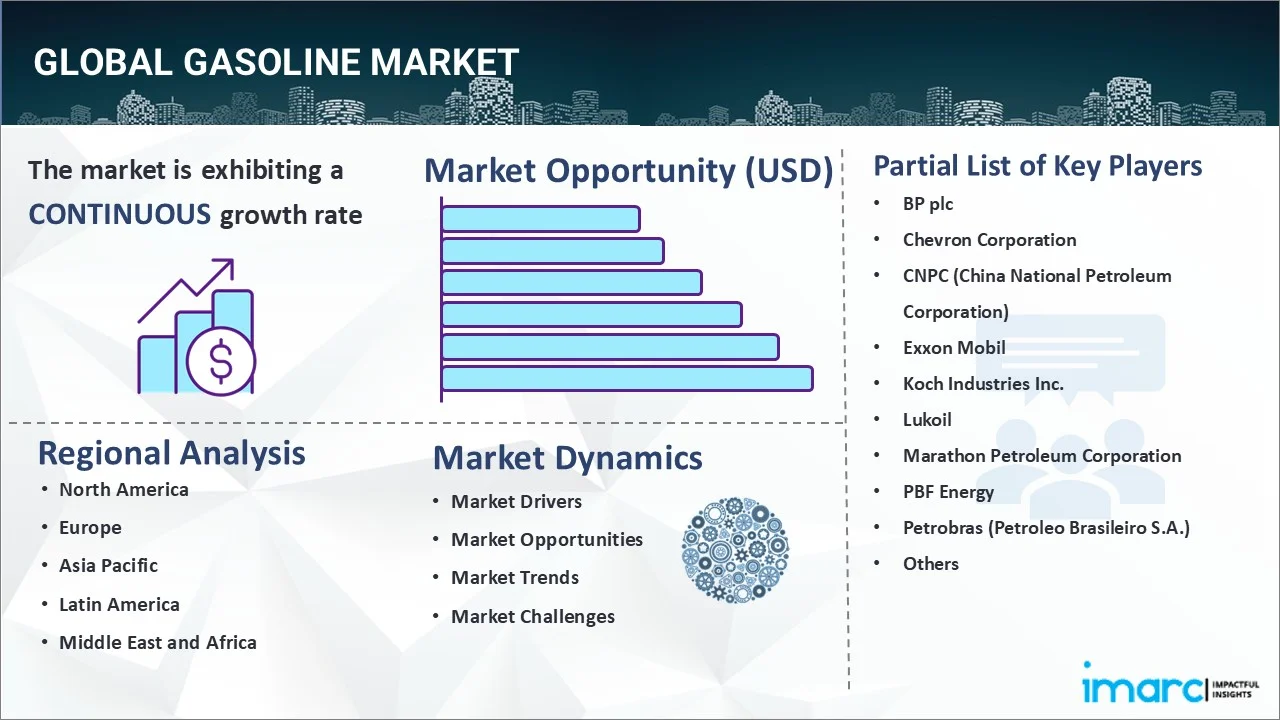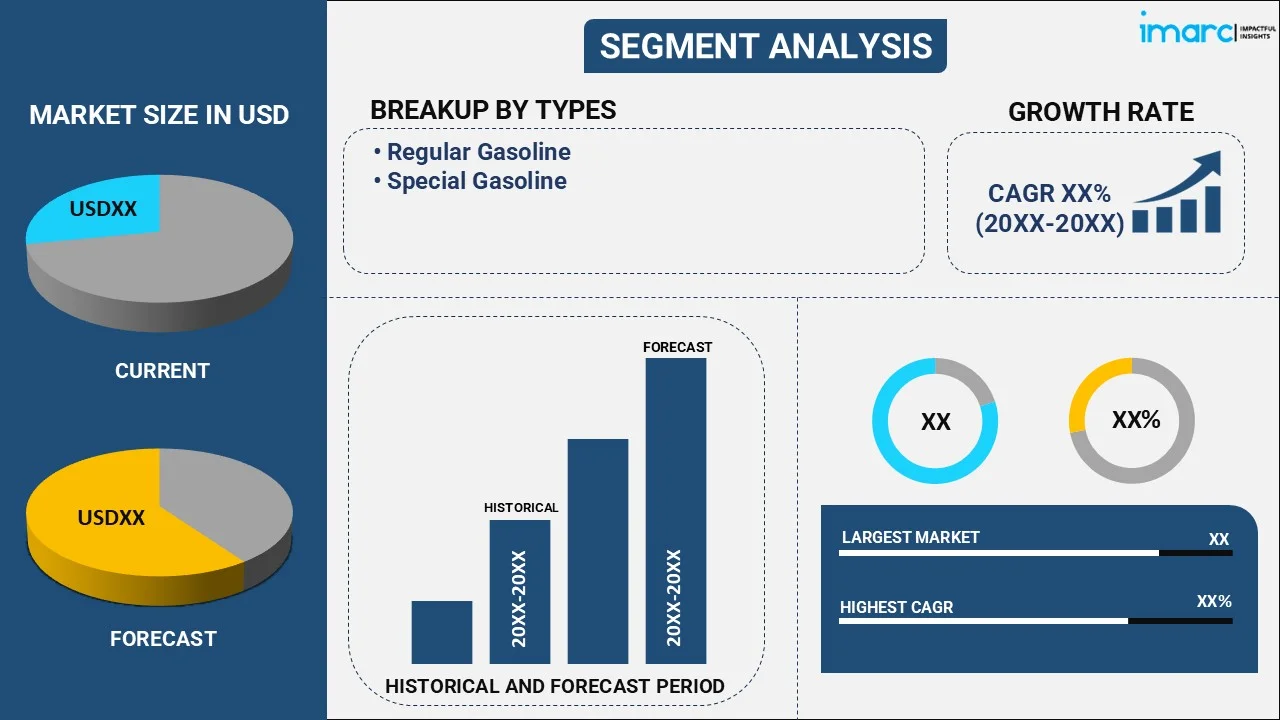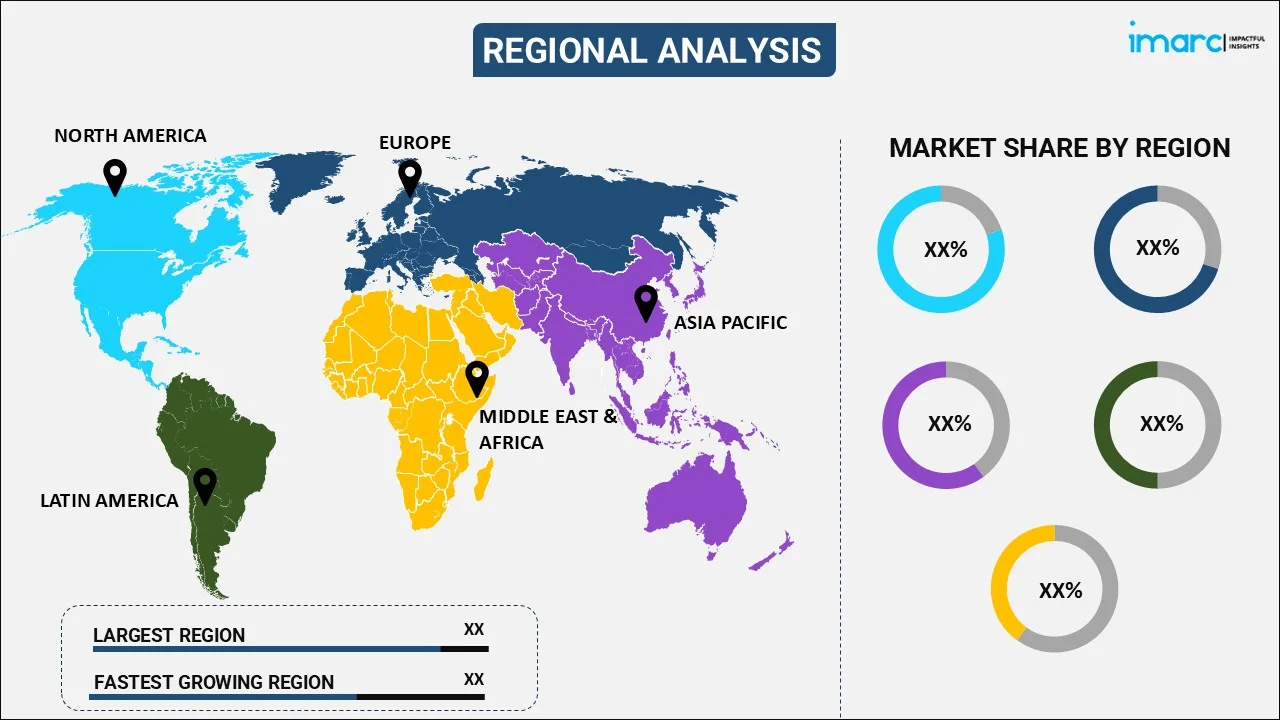
Gasoline Market Size, Share, Trends and Forecast by Type, Application, and Region, 2025-2033
Gasoline Market Size and Share:
The global gasoline market size reached USD 129.5 Billion in 2024. The market is projected to reach USD 145.7 Billion by 2033, exhibiting a growth rate (CAGR) of 1.38% during 2025-2033. The market growth is attributed to increased vehicle ownership, rapid urbanization, expanding industrial activities, advancements in refining technologies, and fluctuations in crude oil prices.
Market Insights
- North America dominated the gasoline market in 2024.
- On the basis of type, the market is divided into regular gasoline and special gasoline.
- Based on application, the automobile segment leads the market in 2024.
Market Size & Forecast:
- 2024 Market Size: USD 129.5 Billion
- 2033 Projected Market Size: USD 145.7 Billion
- CAGR (2025-2033): 1.38%
- North America: Largest market in 2024
Gasoline, also known as petrol, is a commonly used fossil fuel primarily derived from crude oil through a refining process. It is a vital source of energy for internal combustion engines, particularly in automobiles. Gasoline is characterized by its liquid form at room temperature and its combustible properties, making it an ideal choice for powering vehicles. Moreover, its high energy density ensures efficient fuel combustion, contributing to the mobility and convenience we enjoy today. One of the primary advantages of gasoline is its portability, allowing vehicles to carry enough fuel for extended journeys without cumbersome storage requirements. Additionally, gasoline engines are known for their quick start-up and smooth operation, making them suitable for a wide range of applications. There are several types of product variants available, typically classified based on their octane rating, which denotes their resistance to engine knocking.

To get more information on this market, Request Sample
The global gasoline market is primarily stimulated by the increasing demand for efficient motor fuels across the globe. This is further bolstered by the rising automobile sales and the expansion of transportation networks. Furthermore, the modernization of gasoline production methods and its swift adoption in various applications, including portable generators, landscaping equipment, and power tools, contribute positively to the market's growth. Additionally, there is a growing need for gasoline in power plants for various industrial purposes and power generation, further fueling the market expansion. Besides this, the ease of access to gasoline products at numerous gas stations is acting as another growth-inducing factor. Other factors, such as the rising disposable incomes, burgeoning automobile parts production, substantial growth in the aviation sector, the widespread use of high-end sports cars, and extensive research and development (R&D) activities by industry leaders, are propelling the market growth.
Gasoline Market Trends:
Rising Need for Efficient Motor
The increasing demand for efficient motor fuels is a central driver of the global gasoline market. This can be attributed to the global proliferation of automobiles and expanding transportation networks. As more people and businesses rely on vehicles for commuting and logistics, the need for a reliable and efficient motor fuel like gasoline continues to grow. Gasoline’s energy density and ease of use make it a preferred choice for internal combustion engines. In addition to conventional vehicles, gasoline is also utilized in various off-road applications, such as portable generators, landscaping equipment, and power tools. Its versatility in catering to diverse transportation and equipment needs bolsters its demand and further enhances the gasoline market outlook.
Utilization in Various Applications
Gasoline's accelerated application across various uses other than transportation is also a key driver influencing the market. Besides fueling cars, gasoline finds application in portable generators, gardening equipment, power tools, and machinery. This application diversity maintains market stability as it becomes a necessary source of energy for many industries and homes. Gasoline's reliability, simplicity of use, and energy density make it a sought-after fuel for driving various equipment and appliances, guaranteeing a consistent demand base. The prominent players in the U.S. gasoline industry, including Shell, Exxon Mobil, Chevron Corporation, Koch Industries Inc., Lukoil, PBF Energy, and Marathon Petroleum Corporation, form an integral part of this stability. Furthermore, firms such as BP Plc, which is listed by IBISWorld as a major participant in the Gasoline & Petroleum Wholesaling industry, play a role in keeping gasoline at the forefront of the market. Furthermore, with advancements in technology, innovations in the development of machinery and engine design are bound to enhance the efficiency and versatility of gasoline-powered equipment further, keeping it viable in the market.
Modernization in Gasoline Production
The modernization of gasoline production processes significantly augments the gasoline market share. Advances in refining technology and production methods enhance the efficiency of gasoline production, making it more cost-effective and environmentally friendly. These advancements not only increase the availability of gasoline but also help maintain its competitiveness in the market. The optimization of production processes allows gasoline to meet stringent environmental regulations, reducing emissions and improving its environmental footprint. This modernization aligns with the broader global shift toward cleaner and more sustainable energy sources, positioning gasoline as a transitional fuel in the energy transition.
Gasoline Industry Segmentation:
IMARC Group provides an analysis of the key trends in each segment of the global gasoline market report, along with forecasts at the global, regional and country levels from 2025-2033. Our report has categorized the market based on type and application.
Breakup by Type:

- Regular Gasoline
- Special Gasoline
The report has provided a detailed breakup and analysis of the market based on the type. This includes regular gasoline and special gasoline.
The key factors driving the regular gasoline segment include its affordability and widespread availability. Regular gasoline is the go-to choice for the majority of consumers due to its lower cost compared to specialized blends. Additionally, the compatibility of regular gasoline with a broad range of vehicles and equipment ensures consistent demand. According to the gasoline market dynamics, rising consumer preferences for fuel-efficient vehicles also contribute to this segment’s growth, as regular gasoline typically meets the needs of these vehicles while remaining cost-effective.
In the special gasoline segment, factors such as performance enhancement and environmental concerns play pivotal roles. Specialized gasoline blends, often with higher octane ratings, cater to high-performance and luxury vehicles, meeting their specific engine requirements. Furthermore, the growing emphasis on reducing emissions and enhancing fuel efficiency drives demand for special gasoline variants with additives designed to clean engines and improve combustion. This is contributing to a notable expansion in the gasoline market share, as consumers and regulators alike prioritize cleaner and more efficient fuel options. Moreover, environmental regulations and the surging demand for cleaner-burning fuels are key drivers in this segment's expansion, appealing to both eco-conscious consumers and performance enthusiasts.
Breakup by Application:
- Motorcycle
- Automobile
- Others
Automobile dominates the market
The report has provided a detailed breakup and analysis of the market based on the application. This includes motorcycle, automobile, and others. According to the report, automobile represented the largest segment.
The automobile segment dominates the market in 2024. The segment is primarily driven by the surging consumer demand for automobiles, spurred by urbanization, increasing disposable incomes, and improving living standards. As more people seek personal mobility and the convenience of owning a vehicle, the need for gasoline as a primary fuel source for internal combustion engines remains strong. In line with this, regulatory trends promoting fuel efficiency and emissions reduction play a pivotal role. Stricter emissions standards push automakers to develop vehicles with better fuel efficiency, which, in turn, drives the demand and contributes to gasoline market growth. Additionally, while EVs gain traction, conventional gasoline-powered vehicles still dominate the market, and the transition to EVs takes time, maintaining the demand for gasoline. Furthermore, technological advancements in engine design, including hybrid systems, continuously improve the fuel efficiency of gasoline-powered vehicles, making them an attractive choice for consumers concerned about both environmental impact and practicality.
Breakup by Region:

- North America
- United States
- Canada
- Asia-Pacific
- China
- Japan
- India
- South Korea
- Australia
- Indonesia
- Others
- Europe
- Germany
- France
- United Kingdom
- Italy
- Spain
- Russia
- Others
- Latin America
- Brazil
- Mexico
- Others
- Middle East and Africa
North America exhibits a clear dominance, accounting for the largest gasoline market share
The market research report has also provided a comprehensive analysis of all the major regional markets, which include North America (the United States and Canada); Europe (Germany, France, the United Kingdom, Italy, Spain, Russia, and others); Asia Pacific (China, Japan, India, South Korea, Australia, Indonesia, and others); Latin America (Brazil, Mexico, and others); and the Middle East and Africa. According to the report, North America represented the largest segment.
In 2024, North America accounted for the largest market share in the market. The growth of the market in the region is propelled by high rates of auto ownership, extensive transportation infrastructure, and a well-established refining complex. The United States is among the world's largest consumers and producers of gasoline, with demand influenced by individual car usage and suburban commuter behavior. As per the gasoline market analysis, Canada also makes significant contributions to the market, both as an exporter and producer, driven by its abundant natural resource endowment. Additionally, the region has one of the most sophisticated refining capabilities in the world, which enables it to meet domestic consumption and export refined products to other markets. Apart from this, regulatory systems and strategic petroleum reserves also stabilize supply and moderate price volatility. While the shift towards electric cars and alternative energy continues to redefine the demand profile, the gasoline market in North America remains dominant due to its established infrastructure and ongoing economic dependence on conventional fuels for transportation and logistics.
Competitive Landscape:
The competitive landscape of the gasoline market is characterized by intense rivalry among numerous players globally. These competitors range from major integrated oil companies to independent refineries and retailers. Market dynamics are influenced by factors such as supply chain efficiencies, product quality, and pricing strategies. Key areas of competition include the exploration and extraction of crude oil, refining processes, distribution networks, and retail operations.
In the upstream sector, oil companies compete for access to oil reserves and engage in exploration and drilling activities. The efficiency of these operations can significantly impact the availability and cost of crude oil, which is the primary raw material for gasoline production. In the downstream sector, competition revolves around refining capacity and technology. More efficient refineries can produce gasoline at lower costs, giving them a competitive edge. According to the gasoline market research report, distribution networks also play a crucial role, with companies vying for strategic locations and efficient logistics to ensure timely delivery to retailers. At the retail level, gasoline stations compete for consumers based on factors like location, pricing, and the quality of ancillary services. Some stations may differentiate themselves by offering convenience stores, car wash facilities, or loyalty programs.
The report provides a comprehensive analysis of the competitive landscape in the gasoline market with detailed profiles of all major companies, including:
- BP plc
- Chevron Corporation
- CNPC (China National Petroleum Corporation)
- Exxon Mobil
- Koch Industries Inc.
- Lukoil
- Marathon Petroleum Corporation
- PBF Energy
- Petrobras (Petroleo Brasileiro S.A.)
- Reliance Industries Limited
- Saudi Arabian Oil Co. (Saudi Aramco)
- Valero
Recent Developments:
- In August 2025, Nigeria’s Dangote Oil Refinery will begin its own diesel and gasoline distribution nationwide, bypassing third-party logistics by deploying 4,000 CNG‑powered tankers and over 100 support stations. The initiative aims to reduce fuel prices, improve rural supply, and offer credit facilities for bulk buyers purchasing over 500,000.
- In June 2025, Costco is set to launch its first stand-alone gas station, featuring 40 fuel pumps and designed exclusively for Costco members. The move highlights Costco’s strategy to expand its gasoline retail operations. Slated to open in spring 2026, the station will handle approximately 9,500 vehicles daily with up to nine daily fuel deliveries and offers expanded service capacity to better manage traffic at busier warehouse locations.
- In May 2025, Aircela unveiled the first U.S. machine capable of producing fossil-free, engine‑ready gasoline directly from ambient air, water, and renewable electricity. Demonstrated on a New York rooftop, the device captures approximately 10 kg of CO₂ per day, yielding about one gallon of gasoline, and aims for commercial deployment by this fall to support distributed carbon‑neutral fuel production.
- In August 2023, Chevron Corporation acquired PDC Energy, creating Colorado's largest oil and gas company. The new company will now hold 600,000 acres statewide; about half of that in the Denver-Julseburg Basin adjacent to Chevron's existing operations. It will produce 400,000 barrels of oil per day on average, making it one of Chevron's top five production units in the world.
- In June 2023, Saudi Arabian Oil Co. (Aramco) and TotalEnergies SE were awarded the rights for the building of an $11-billion petrochemicals complex in Saudi Arabia.
- In September 2023, Foresea secured a new rig contract worth $400 million with Petrobras.
Gasoline Market Report Scope:
| Report Features | Details |
|---|---|
| Base Year of the Analysis | 2024 |
| Historical Period | 2019-2024 |
| Forecast Period | 2025-2033 |
| Units | Billion USD |
| Scope of the Report | Exploration of Historical Trends and Market Outlook, Industry Catalysts and Challenges, Segment-Wise Historical and Predictive Market Assessment:
|
| Types Covered | Regular Gasoline, Special Gasoline |
| Applications Covered | Motorcycle, Automobile, Others |
| Regions Covered | Asia Pacific, Europe, North America, Latin America, Middle East and Africa |
| Countries Covered | United States, Canada, Germany, France, United Kingdom, Italy, Spain, Russia, China, Japan, India, South Korea, Australia, Indonesia, Brazil, Mexico |
| Companies Covered | BP plc, Chevron Corporation, CNPC (China National Petroleum Corporation), Exxon Mobil, Koch Industries Inc., Lukoil, Marathon Petroleum Corporation, PBF Energy, Petrobras (Petroleo Brasileiro S.A.), Reliance Industries Limited, Saudi Arabian Oil Co. (Saudi Aramco), Valero, etc. |
| Customization Scope | 10% Free Customization |
| Post-Sale Analyst Support | 10-12 Weeks |
| Delivery Format | PDF and Excel through Email (We can also provide the editable version of the report in PPT/Word format on special request) |
Key Benefits for Stakeholders:
- IMARC’s industry report offers a comprehensive quantitative analysis of various market segments, historical and current market trends, market forecasts, and dynamics of the gasoline market from 2019-2033.
- The research report provides the latest information on the market drivers, challenges, and opportunities in the global gasoline market.
- The study maps the leading, as well as the fastest-growing, regional markets. It further enables stakeholders to identify the key country-level markets within each region.
- Porter's five forces analysis assist stakeholders in assessing the impact of new entrants, competitive rivalry, supplier power, buyer power, and the threat of substitution. It helps stakeholders to analyze the level of competition within the gasoline industry and its attractiveness.
- Competitive landscape allows stakeholders to understand their competitive environment and provides an insight into the current positions of key players in the market.
Key Questions Answered in This Report
The gasoline market was valued at USD 129.5 Billion in 2024.
The gasoline market is projected to exhibit a CAGR of 1.38% during 2025-2033, reaching a value of USD 145.7 Billion by 2033.
The market is driven by factors such as increasing global vehicle production, rising demand for transportation fuels, and urbanization. Economic growth in emerging markets boosts fuel consumption, while advancements in refining technologies and the stability of supply chains also contribute to the market’s continued growth.
North America currently dominates the gasoline market in 2024. The dominance is fueled by high vehicle ownership rates, the large-scale presence of refineries, and consistent demand for gasoline in the region. Additionally, the extensive distribution network and strong infrastructure for fuel delivery further support its market share dominance.
Some of the major players in the gasoline market include BP plc, Chevron Corporation, CNPC (China National Petroleum Corporation), Exxon Mobil, Koch Industries Inc., Lukoil, Marathon Petroleum Corporation, PBF Energy, Petrobras (Petroleo Brasileiro S.A.), Reliance Industries Limited, Saudi Arabian Oil Co. (Saudi Aramco), and Valero, among others.
Need more help?
- Speak to our experienced analysts for insights on the current market scenarios.
- Include additional segments and countries to customize the report as per your requirement.
- Gain an unparalleled competitive advantage in your domain by understanding how to utilize the report and positively impacting your operations and revenue.
- For further assistance, please connect with our analysts.
 Request Customization
Request Customization
 Speak to an Analyst
Speak to an Analyst
 Request Brochure
Request Brochure
 Inquire Before Buying
Inquire Before Buying




.webp)




.webp)












